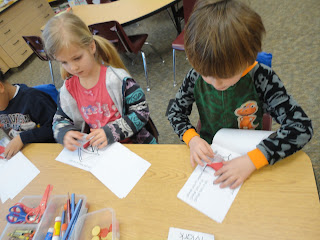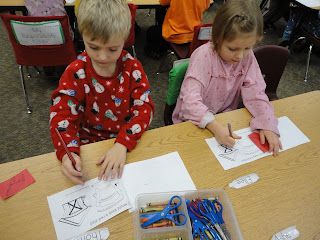We are really picking up the pace with reading now that everyone knows their letters and sounds!
It's time for WORD FAMILIES!!!! YAY!!! I just love word families because the kids think we are just playing and they pick them up so quickly.
Here the kids are putting a red sled in bed and in a shed:
They thought it was SO fun to interact with the book.
On the last page the kids get to decide where they would put the red sled and fill it in.
In case you couldn't tell, this was also pajama day at school
This lesson and many more hands on word family activities can be used to enhance your child's learning experience at home. Give your child an academic boost by visiting http://education.byu.edu/seel/library/category/217
Here's a great explanation of why word families are SO important:
Word families, sometimes called phonograms or chunks, can really help emergent readers begin to understand our complicated, and often inconsistent, language by providing some predictable patterns within words. When learning to read, patterns are important. Children recognize word patterns and this makes it easier when sounding out words.
For example, consider the "est" word family. First, show "est" to your child and have him/her repeat the sound. Then show the word "best" and demonstrate how you can read the word by first making the "b" sound and then the "est". Repeat it slowly and then more quickly. Now continue with some other members of the "est" family such as nest, pest, rest, test, vest, west.
Can you see how much easier this method of using chunks of letters is compared to sounding out one letter at a time? We break words into chunks naturally as skilled readers and teaching children this skill can help them learn to read.
What is even better is that once children learn the 37 most common word families in English, they will be able to decode 500 words! That puts emergent readers well on their way to mastering the entire decoding process. The most common word families include: ack, ain, ake, ale, all, ame, an, ank, ap, ash, at, ate, aw, ay, eat, ell, est, ice, ick, ide, ight, ill, in, ine, ing, ink, ip, it, ock, oke, op, ore, ot, uck, ug, ump, unk.
Word families are indeed an efficient way to get children reading. Once children learn these one-syllable phonograms then they will more easily be able to decode longer words too.
For example, consider the "est" word family. First, show "est" to your child and have him/her repeat the sound. Then show the word "best" and demonstrate how you can read the word by first making the "b" sound and then the "est". Repeat it slowly and then more quickly. Now continue with some other members of the "est" family such as nest, pest, rest, test, vest, west.
Can you see how much easier this method of using chunks of letters is compared to sounding out one letter at a time? We break words into chunks naturally as skilled readers and teaching children this skill can help them learn to read.
What is even better is that once children learn the 37 most common word families in English, they will be able to decode 500 words! That puts emergent readers well on their way to mastering the entire decoding process. The most common word families include: ack, ain, ake, ale, all, ame, an, ank, ap, ash, at, ate, aw, ay, eat, ell, est, ice, ick, ide, ight, ill, in, ine, ing, ink, ip, it, ock, oke, op, ore, ot, uck, ug, ump, unk.
Word families are indeed an efficient way to get children reading. Once children learn these one-syllable phonograms then they will more easily be able to decode longer words too.
-from http://mrsmayersgracefieldkindergartenclass.blogspot.com/2009/09/word-families.html






No comments:
Post a Comment